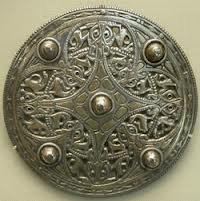Secret histories of illuminated manuscripts: the MINIARE project
Secret histories of illuminated manuscripts: the MINIARE project From the University of Cambridge An innovative project at the University of Cambridge will uncover…
The Great Age of Books: The 14th and 15th Centuries
In this video, Hobbins discusses his research on the tremendous changes in book production in the late Middle Ages, before the advent of print.
Dating medieval English charters
Developing a computer program that can automatically date medieval manuscripts.
A Christological reading of The Ruin
We should be aware that the semantic scope of each word may vary drastically and that the reader is influenced by many variables in attaching the meaning to a given word. The question becomes trickier if we take the allegorical viewpoint, because polysemy is concerned with the entire text, not with just a word. Thus, we should not consider the surface meaning of the words, but look more carefully for the covert meanings.
Early Irish Manuscripts: The Art of the Scribes
The Irish have always loved words.
The Cross as Tree: The Wood-of-the-Cross Legends in Middle English and Latin Texts in Medieval England
The wood-of-the-cross legend is actually a group of narratives that trace the pre- history of the wood used to make Christ’s cross back to Old Testament figures, or in some cases back to paradise itself.
New Testament from the oldest complete Bible available online for the first time
The New Testament volume from one of the British Library’s most valuable treasures, Codex Alexandrinus, has been made available online for the first time on the British Library’s website.
In It for the Money: The Birth of Commercial Book Production
This lecture introduces the main players of this world of medieval book commerce — parchment makers, paid scribes, illuminators, shopkeepers — and discusses why these traditionally separate professions blended into a closely knit community that stands at the cradle of our bookish world today.
The Geese Book – medieval manuscript now available online
One of the most interesting manuscripts of the late Middle Ages is now available online – The Geese Book, a lavishly and whimsically illuminated, two-volume liturgical book, can now be accessed through a project from the Arizona Center for Medieval and Renaissance Studies.
New Book on ‘The Book of Kells’ launched
This new publication, presented in a cloth-bound slipcase, features 84 full-size reproductions of complete pages of the manuscript, while enlarged details allow one to relish the intricacy of elements barely visible to the naked eye.
Medieval Book History Week Lecture: “Practical Latin and Formal English in the 14th-15th Centuries”
This lecture is part of Medieval Book History Week. Renown Professor Jeremy Catto spoke about literacy and language in England during the later Middle Ages at the Pontifical Institute of Mediaeval Studies at the University of Toronto.
University of Exeter to create app showcasing Anglo-Saxon manuscripts
The world’s largest collection of Anglo-Saxon poetry may soon be available on a smart device App, as part of a project initiated by the University of Exeter.
St Augustine Was Eaten by a Bear: Book Production in Carthusian Monasteries
So stop reading and lets think about physical appearance: what does it look like, what does it feel like, what does it smell like.
Crowdsourcing the Medieval Text: New Avenues for Examining Leaves and Fragments
This paper will argue that while formal institutional websites are useful for highly professional and specialized projects, broader and more popular social media and photo-sharing sites such as Flickr and Facebook offer the potential to provide an easier and more widely accessible platform for exploring (i.e. crowdsourcing) medieval manuscript fragments.
Excusing the Inexcusable: Abbots Who Diminish the Patrimony, and the Monks Who Love Them Anyway
This paper was part of the fantastic SESSION IV: Abbots between Ideals and Institutions, 10th–12th Centuries. This paper focused on the writing about abbots during the tumultuous period of Stephen’s reign.
“The Self and the Other: Migration and Ethnicity in Late Anglo-Saxon England”
This paper was part of the session: SESSION II: Who Do They Think They Are? and dealt with Anglo-Saxon migration, names and charters.
Christian Living Explained: Alcuin’s De virtutibus et vitiis liber in a Carolingian Instructional Manual
Another paper from the yesterday’s SESSION I: Lived Religion in the Middle Ages. This paper focused on Alcuin of York’s contribution to the standardisation of Carolingian Christian texts for pastoral instruction.
Magical Dream Provocation in the Later Middle Ages
Hidden in the manuscripts of illicit magic we may find a hitherto untreated practical literature of dream divination…this literature sets out to provoke specific kinds of dreams.
Authors, Scribes, Patrons and Books
This essay gives an account of the social role of manuscripts and early printed books and the processes by which they were made, processes that changed greatly during the period
The ruling as a clue to the make-up of a medieval manuscript
The purpose of this inquiry is to try to reconstruct the original state of the manuscript using ruling as a clue.
The Librarius and Libraire as Witnesses to the Evolving Book Trade in Ducal Brittany
In monasteries and cathedrals of the medieval West, the « custos librariae » functioned primarily as a custodian or keeper of bound codices, and we see a similar role emerge from extant medieval registers from Breton cathedral chapters.
Textile and Embroidered Bookbindings of Medieval England and France
These are rich, elaborately crafted objects that required binders to collaborate with craft persons skilled in needlework. Beautifully woven fabrics were used, some of which were made for clothing.
The Naples L’homme arme masses, Burgundy and the Order of the Golden Fleece: The origins of the L’homme arme tradition
The six anonymous L’Homme arme masses in naples MS VI E 40, of the Biblioteca Nazionale, have prompted heated debate concerning their genesis since Dragan Plamenac discovered them in 1925.
The Rare Oxford Machzor Vitry: A Rosh Hashana essay
The Machzor Vitry work is, as mentioned above, not just a prayer book but includes much more, including many laws and a commentary. It consists of three portions; the halakhic legal portion, the liturgical formulae, and commentaries to the prayers taken from the aggadah.
The Forgotten Text of Nikolai Golovin: New Light on the Igor Tale
Mann argues that a rare text of the Skazanie o Mamaevom poboishche comes from an early, fifteenth-century redaction that scholars could never locate—a redaction that is the prototype for all the redactions that have been studied heretofore. He maintains that unique parallels between this redaction and the Slovo o polka Igoreve support the hypothesis that the Igor Tale was an oral epic song in a tradition that actually continued into the fourteenth and fifteenth centuries, when oral tales about the Kulikovo Battle (1380) were composed. He places the new parallels in the context of other evidence for oral composition in the Igor Tale.












